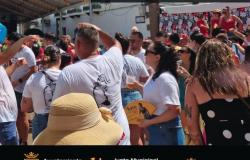Barcelona, June 20 (EFE).- The ‘cyclors’ or cycling crew members of the AC75 (monohulls with foils measuring 22.90 meters in length) with which the teams of the 37th America’s Cup in Barcelona will compete “provide a increase in power from 30 to 50 percent using the lower part of the body instead of the upper part,” Australian Ben Day, performance coach of the American ‘American Magic’, explained in a meeting with the reconnaissance team.
Day, a 45-year-old Australian, resident in the United States and former ProTour professional cyclist, has been on the American team since October 2022 and did not hesitate about the type of element he needed to be a ‘cyclor’.
“We needed to find very strong and robust athletes because this is not a power-weight sport; it is simply an absolute power sport,” he said.
In each AC75 there will be four ‘cyclors’ who, with their legs and pedaling in a synchronized manner on advanced stationary bicycle systems, will be able to propel the AC75 to 55 knots (101 km/h). The technological revolution of ‘cyclors’ is based on a mechanism similar to the transmission system of a fixed gear bicycle.
The America’s Cup regulations require a minimum crew weight for the four ‘cyclors’ (power group) and the four of the ‘power’ group (2 helmsmen and 2 trimmers) that direct the boat, so the choice with A limited group of ‘cyclors’ between 90 and 105 kilograms in weight and 1.98 meters was a complicated task.
“It is very rare to find a professional cyclist who weighs more than 80 kilograms because the power-weight relationship in cycling governs everything. Cyclists can control both variables in the power-weight equation,” Day remarked to EFE.
“Training can increase energy production, measured in watts – he continued – and they can also lose weight to improve their power-to-weight ratio. The best professionals are extremely efficient in their energy production and surprisingly lean.”
Day expanded his search to other endurance sports and found 210-pound, 6-foot-3 swimmer Colton Hall and 95-pound American K-1 and Olympic kayak record holder. and 1.91 meters, Tim Hornsby.
The rest of the ten-member ‘cyclor’ group included a diverse group of rowers, sailors, track athletes and professional cyclists.
The selection testing protocol was very tough. Those chosen had to produce a power of more than 1,100 watts for 30 seconds, more than 540 watts for four minutes and more than 440 watts for a 20-minute range. In addition to intense work in the gym, sessions on the smart stationary bikes were a key part of the training regime.
The AC75 requires significant power to perform maneuvers such as tacking, jibing and turning around buoys. The ‘cyclors’ cannot top off the hydraulic system and stop pedaling to take a break during racing, so athletic performance, strength and endurance directly affect the team’s results.
Quick trim of the sails improves the responsiveness of the boat, and the harder and faster the ‘cyclors’ pedal, the more quickly the power will be available. The AC75’s hydraulic accumulator tank stores the pressure generated by pedaling, rather than pedaling directly moving anything mechanically on its own.
The hydraulic accumulator converts this pressure into force. As the pressure in the tank is used, the ‘cyclors’ must pedal harder to maintain it. The fuller the tank, the harder it is to add more pressure and the harder riders will have to pedal.
To carry out the system, the team partnered with SRAM, the most innovative American bicycle component manufacturer in the world, who designed the flywheelless transmission, which they coupled to the AC75’s hydraulic system and directly to the rig for certain maneuvers.
Additionally, the Americans have opted for ‘cyclors’ in a reclined and relaxed position, but also facing aft (to the stern of the AC75) rather than forward (towards the bow), with two ‘cyclors’ on the port side and starboard of the hull, with the transmissions connected in tandem.
During the pre-start period, the ‘cyclors’ perform multiple high-intensity anaerobic efforts as the boats compete to gain position over their rival.
The demands of more intense racing include sub-threshold efforts during straight-line sailing, interspersed with high-intensity efforts during maneuvers. A ‘cyclor’ will usually have a normalized power in the range of 350 to 450 watts for an effort of 700 kilojoules.
Day did not comment when asked for specific details of his training regimen with the Cyclors. He only revealed that they train between 15 and 20 hours per week on stationary bikes and in the gym. EFE
1010560
srb/fa/nam






